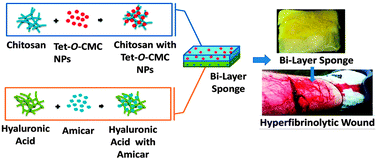Drug loaded bi-layered sponge for wound management in hyperfibrinolytic conditions
Abstract
Excessive bleeding due to premature clot lysis and secondary bacterial wound infection are two significant problems that contribute to increased morbidity in patients with hyperfibrinolytic conditions. In this study, we have developed a bi-layered sponge that promotes fibrin clot stability and prevents secondary bacterial wound infections. Using the technique of freeze-drying, a bi-layer matrix consisting of hyaluronic acid (HA) containing aminocaproic acid (amicar) and chitosan containing tetracycline loaded O-carboxymethyl chitosan nanoparticles (Tet-O-CMC NPs) were produced. We hypothesized that the top chitosan layer with Tet-O-CMC NPs will prevent wound infection and concomitantly act as a matrix for cellular migration and subsequent wound healing, while the amicar-containing layer would promote clot stability. Tet-O-CMC NPs and bi-layer sponges were characterized using Dynamic Light Scattering (DLS), Scanning Electron Microscopy (SEM) and Fourier Transform Infra Red (FT-IR) spectroscopy. Physiochemical characterization such as porosity, swelling and mechanical testing was performed. The drug release study shows that the bi-layered sponge demonstrates a robust burst release of amicar and a sustained release of tetracycline. The ex vivo muscle permeation study indicated that Tet-O-CMC NPs have enhanced tissue permeation compared to free Tet. In vitro antibacterial activity of the bi-layer sponge towards laboratory and clinical strains of Staphylococcus aureus and Escherichia coli was proved. The ex vivo bacterial sensitivity study using porcine muscles confirmed the antibacterial activity, while the cell viability study using human dermal fibroblast (HDF) cells revealed its biocompatible nature. The in vitro antifibrinolytic study shows that the bi-layered sponge with amicar showed significant protection against streptokinase induced clot lysis. These studies suggest that the prepared amicar and tetracycline loaded chitosan–HA bi-layered sponge can be used effectively to promote better wound healing by simultaneously preventing bacterial infection, and enhancing clot stability.


 Please wait while we load your content...
Please wait while we load your content...